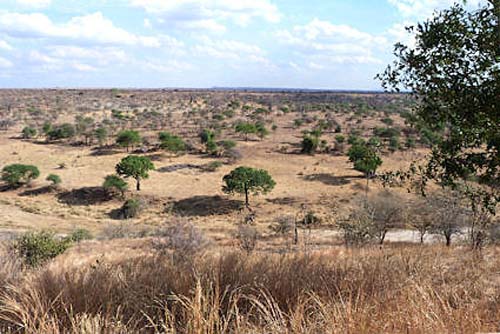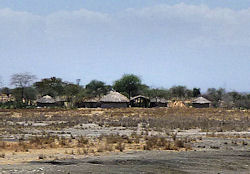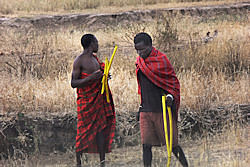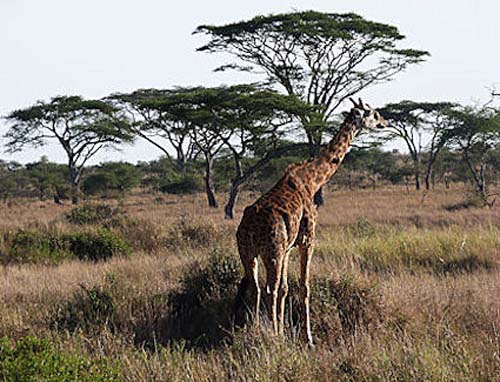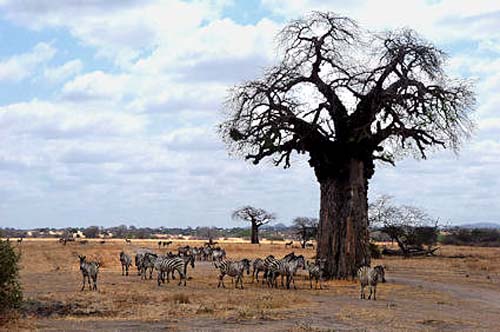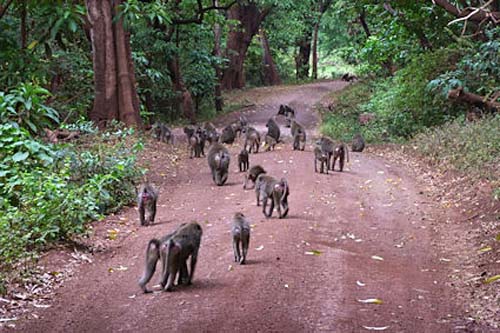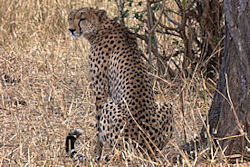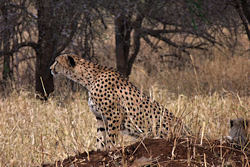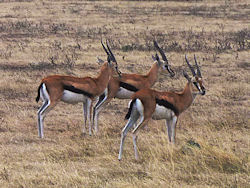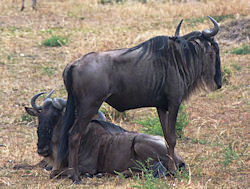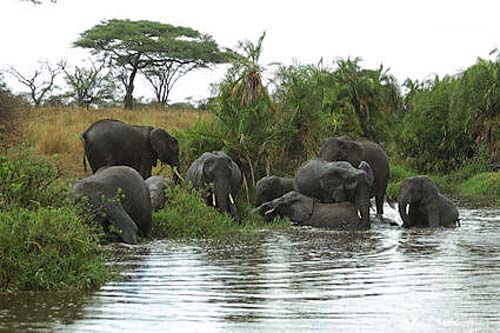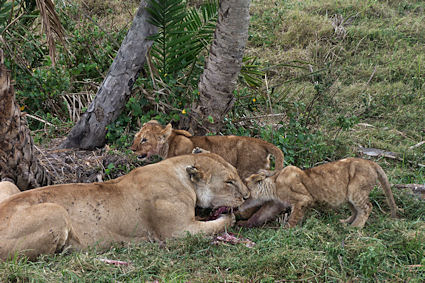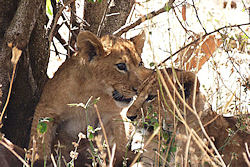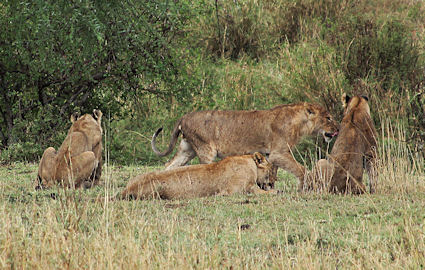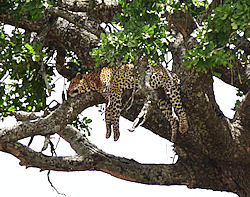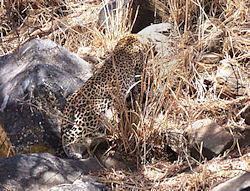When you first visit a sub-Saharan country, in our case Tanzania, on a safari tour, you easily get the impression that this is paradise. Wild animals in a healthy environment who live together, most of them getting along wonderfully well. Obviously though, in spite of the superficial impression of peace, when you see a lioness with her two cubs tearing at the pieces of a recent kill, you realize that what governs the lives of these wild beasts is the law of the jungle.
These precious wild animals are in constant danger from poachers and also from farmers who kill the wild beasts that attack their herds of domestic animals. It seems self-evident how enormously important it is to keep protecting these precious islands of wildlife in the world.
After a few days of safari and after asking questions about the government and the way of life of the people, I got the impression that this was one of the very few peaceful countries in Africa, unspoiled by the multinational corporations and corrupt leaders. The truth is, however, that Tanzania is not very different from most other African countries.
So far the national parks are untouched, thanks to the first president, Julius K. Nyerere, of the newly independent republic of Tanzania (1964- 1985)[1]
“Nearly 50 years ago the first President of Tanzania, Mwalimu Julius K. Nyerere, recognized the integral part wildlife plays in the country. In September 1961 at a symposium on the Conservation of Nature and Natural Resources, he gave a speech that has become known as the Arusha Manifesto:
“The survival of our wildlife is a matter of grave concern to all of us in Africa. These wild creatures amid the wild places they inhabit are not only important as a source of wonder and inspiration but are an integral part of our natural resources and our future livelihood and well being.
“In accepting the trusteeship of our wildlife we solemnly declare that we will do everything in our power to make sure that our children’s grand-children will be able to enjoy this rich and precious inheritance.
“The conservation of wildlife and wild places calls for specialist knowledge, trained manpower, and money, and we look to other nations to co-operate with us in this important task—the success or failure of which not only affects the continent of Africa but the rest of the world as well.”
Nyerere was not perfect, and his plans were not very successful for the economy of the new country, but he is still seen as the Father of the Nation, the same as Nehru in India. His statue is to be seen in the big city squares—again, the same as Nehru’s in Indian cities. Most Tanzanians are still today devoted to him. African socialism was something different from Western socialism and Nyerere wasn’t isolated in his ambitions to make Tanzania a country independent of Western colonialism.[2]
Quote from ‘A Discourse on African Socialism’
“In one of his leading discourses titled ‘African Socialism Revisited,’ Nkrumah places African socialism in its historical context. ‘Many African societies in different periods of history manifested a certain communalism . . . the philosophy and humanist purposes behind that organization are worthy of capture.’
“To define African socialism therefore, Nkrumah insists that one should look not at the structure but at the spirit of traditional African society ‘ . . . for the spirit of communalism is crystallized in its humanism and in its reconciliation of individual advancement with group welfare.’”
The way Tanzania (a fusion of the former countries Tanganyika and Zanzibar) has developed under subsequent governments seems pretty much to resemble the trend in most other African countries, that is, relative corruption on all levels and dependence on the world rulers, the Corpocrats who own the world. The country does get some profit from their own mines of highly precious minerals and precious stones, but royalties for international mining companies are very far from what the people should have a right to demand. The law of the jungle is the rule in the area of the country’s economy as well as in the wildlife reserves.
Evidently the country would have profited far more if all these resources could have been exploited by their own people. Tanzania is, in spite of its increasing resources, a poor nation, and like in most other third-world countries their resources are being exploited by foreign corporations and not nearly enough paid back to the country that owns the earth that is being mined. It is, as in so many other cases, a matter of cold theft.
However, the people do not look as poverty-stricken as the poor people in India, just to name one country where we have traveled quite extensively. Of course you see men pulling and pushing very heavy loads on handcarts and women carrying huge burdens on their heads. However, it is their way of life and it is not necessarily a sign of dire life after colonialism. Or under neocolonialism for that matter. It’s not like seeing a Dalit woman in India carrying 14 heavy bricks on her head. That breaks your heart. Of course you see people living in one-room huts in Tanzania too, but they have at least one window and a proper door and they look far cleaner than the hovels in India that often give the impression that a heavy puff of wind could blow them over.
There are still Maasai people in northern Tanzania living in the traditional kind of round huts, but those are increasingly being replaced by more modern-looking houses, as their standard of living improves, mainly from cattle breeding. This tribe who has been hounded from fertile lands, just like Native Americans in fact, to desert-like areas, have managed to make a living even out of this arid land where they have ended up. They were also fierce warriors and the Arab slave traders over the past centuries didn’t dare attack them.
We saw their cattle herds all along the roads we were traveling on before entering the National Parks where they are not allowed to let their cattle roam. Goat herds have also been added more recently to their traditional cattle herds. Their cattle eat off the scanty, dry grass on the plains, and since there is nothing left for the wild animals to eat, that becomes a natural way to make them stay inside the reserves where they have the savanna and the forests to themselves.
We visited a Maasai-descended village where the people had taken up agriculture as well, especially banana and coffee plantations and corn, wheat, etc. to feed themselves. Most of the houses here seemed to be of a more comfortable kind. We were welcomed into an old woman’s house that was nothing but a hut and we got a very friendly reception. However, her sons had houses that were far more modern-looking with windows and proper entrance doors.
We were lucky to get in touch with two very well-informed Tanzanians with whom we discussed neocolonialism on my raising the subject. We clearly got what is a reasonable picture of the political situation in Tanzania. Understandably, our safari guide who also was a very well-educated person, had quite a bit embellished the political situation of his country, very likely in good faith. Tourism is one of Tanzania’s principal sources of income and it is important for the agencies and for the country that tourists not be scared off.
We were now made to understand that even though Tanzania is a democracy in the same way as most other countries today, that does not mean that there is no corruption or multinational exploitation of the country’s resources. That does not mean that the well-being of the people is the priority for the politicians. The two men we talked to at some length, openly declared that those in power were in fact puppets of the Corporate World, just like in most other African countries—now that Qaddafi, who tried to go his own way, is gone. And, for that matter, just like EU governments are also puppets of the Corporatocracy.
Agriculture is by far the most important source of income in Tanzania, and gem stones and precious minerals account for a fair percentage as well. Tourism is also becoming increasingly important for the economy of the country, which still remains weak.
As an example of the way the country is on a leash to the Corporations, we learned to our great disappointment that the corn we saw growing all over was GM corn.
There is not only gold and diamonds, but a vast array of other minerals and gem stones eagerly exploited by Western companies. Recently, in a collapsed volcano (the Ngualla) in the southwest, deposits of rare earth elements have been discovered—the world’s fifth largest rare earth deposit outside of China.
There are also recent finds of uranium and the sad truth is that the mining of uranium will most certainly go ahead in the UN World Heritage site, the Selous Game Reserve. The project is the Mkuju River uranium mine in southern Tanzania.[3] This would be a disaster for the wildlife living, until now, very peacefully in that reservation area, which is one of the largest wildlife reserves in the world. International companies are now fighting over who is going to get the profit from this disastrous project.
Our safari
We started out and ended up in the northern city of Arusha, right next to Kilimanjaro which we never saw since the ‘little rain season’ had started and Kilimanjaro was covered in clouds when we were hoping to see it. It’s quite close to the road from Arusha to the airport, which is named the Kilimanjaro International Airport.
We were being driven around in a safari vehicle, a tough, but comfortable 4×4 with a ‘pop-up’ roof that enables you to take photos from inside the vehicle. This is essential since you are not allowed to set foot on the ground in the wildlife reserves and anyway you wouldn’t dare do such a thing with an elephant coming towards you with his ears fiercely flapped out or a lion roaming around right next to the car. We know well that an elephant can overturn even a heavy vehicle and a lion can wound you seriously even if you so much as lean too far out from the opening in the car.
The exception to this rule is the areas that are prepared for your picnics which are daily since you have either breakfast or lunch out, depending on your hour of departure. Those are well taken care of with tables and chairs and western-style restrooms. If you see lots of mice running around under the tables, not to worry. It’s the custom of the country. To make up for those, there are also, at the same time, gorgeous colorful birds to watch, if you don’t care for mice. One time I will never forget we were befriended by a laughing starling. That’s not the name of it, as our guide said offhandedly that it was just a common starling. To me it wasn’t common at all. The bird was definitely laughing at us. Ha ha ha, sounded exactly like a human being making fun of you. I chimed in with him. He was hilarious.
Our plans were to see the wildlife in the National Parks in northern Tanzania. We had a superb guide and driver who was an official guide and as such had studied zoology and botany and he never missed the answer to a question we asked him. And there was no end to those. Nobody is actually allowed inside the national parks or conservation areas without an official guide. There were lots of 4x4s to be seen on the incredibly bumpy trails we were driving on, but they were all from one or another of the official agencies that organize these safaris.
We wanted to see as much as possible, being the animal lovers that we are, as well as lovers of exotic life styles and lands. Well, we got to see all we could possibly have wished for—and more.
We first drove through an extremely arid region where we saw many old-fashioned Maasai huts in tiny villages a bit away from the road and quite a few Maasai men walking along the road. This was not even the savanna—it was just an arid plain.
It was basically when we got to the parks that the savanna took over, higher grass and lots of acacias of the innumerable kinds that exist, from the elegant umbrella acacias to the thorny small-leaved acacia bushes and trees that the giraffes like to eat from.[4]
Acacia trees and huge baobab made up the impressive scenery we were driving through and impalas and zebras were everywhere. Zebras seemed to mix in with all kinds of other animals, antelopes, giraffes, elephants or warthogs—relatives of wild boars, but funnier and uglier.[5]
There were multiple black faced monkeys, blue monkeys, also small, and a huge number of baboons, somewhat bigger and always with babies that were sometimes carried on the backs, sometimes below the bellies of the mother. They could be wandering around in huge groups or be quite isolated. Or they might be sitting or walking all over the road that we were traveling on. In that case, diplomacy was called for.
On our very first day in the Tarangire National Park, we had one of the experiences of our lives. Our guide sighted a cheetah not far from our trail, a cheetah with a young cub.
We were fascinated because it was so close to us and it’s relatively rare to see a cheetah—not at all like lions or even leopards. It’s amazing how all these wild animals were not the least wary of the cars that were driving so close to them. As long as you don’t put a foot on the ground, all is peace and calm. There must be no loud voices though.
From the moment we spotted her with her young one we were completely fascinated and couldn’t stop watching. The cub left his mother and settled on a little mound close by. Mom first kept sitting by the tree, her head pointed towards us, perfectly aware of our presence, the way the animals always are. After a while she joined her cub and sat down next to him on the mound.
But all this time she seemed to have scented game. She was extremely alert to something she flared or saw far away and that we couldn’t possible see. Then all of a sudden, like lightning, she took off and was gone. It was quite a drama and I was thrilled by having seen her taking off.
Another fabulous event was also on our first day out when we suddenly saw a great herd of impalas, first spread out in among the trees with a giraffe as company. They then started walking towards a waterhole and after a while they got mixed in with a herd of wildebeest. These are one of the largest kinds of antelope, even though they don’t really look like antelope. They can be amazingly agile though and hilariously funny when they start hopping. Their antics have earned them the name of ‘the clowns of the savanna.’[6]
We saw antelope of varying sizes every day, from the little dik-diks to the impalas and gazelles, to the wildebeests that seemed ubiquitous, usually in impressively large herds. The largest antelope is the eland, which we never saw. They are huge and they definitely don’t give you the impression of being a kind of antelope, but more like a moose.
The wildebeests (Afrikaans = wild cattle) are the most abundant big-game species in east Africa.
We saw huge herds of buffaloes almost every day, but on our second day of the safari we had a breathtaking experience. As usual, it was our guide who first spotted the masses of buffaloes that were moving in a seemingly endless stream towards a river. Here is the frontal section of what looked almost like a migration of animals. These have already gotten to the river while there are still hundreds behind them, and the huge beasts are busy drinking.
The migrations were in fact taking place when we were there but we were unfortunately not in the right place.
Elephants were with us daily, usually in groups, small or large. They were always impressive as they walked in single file on the side of the road to finally cross it, totally ignoring the little bug that was our Land Cruiser. But the winner was the day we saw the bathing elephants, a group of about ten who were all more or less in a river, playing and showering and even immersing themselves in the water.
It was raining pretty heavily but I still managed to take a video where you can even clearly see the streaks of the rain. Magnificent animals. And awe-inspiring indeed. [7]
But the prize for stately elegance must go the giraffes. We went wild on the first day when we saw our first giraffe, but we were going to see them every day, in singles, twos or threes or bigger groups. Amazing. What a sight seeing a herd of giraffes running or walking in a stately fashion across the savanna.
On our way up to northern Serengeti we witnessed a dramatic show of a lioness with two cubs who were tearing at a killed wildebeest, according to what our guide told us. It was gruesome but
you just have to accept that kind of sight in the wilderness. Gruesome or not, you get so fascinated by these scenes that you just watch forever. In the scene below most of the big carcass is gone and they are eagerly devouring the leftovers. [8]
Here are two young cubs from a more peaceful scene, a lioness with her two cubs which we watched for the longest time on our last drive in Tarangire NP. Mom isn’t in the picture, but she was right next to the kitties.
We would never have dreamed of seeing masses of lions. On the day we were on the road to Ngorongoro from the northern Serengeti NP, we saw a pride of 15 lions, one extremely handsome male, a few adult females and several young ones of varying ages. We were really lucky to get to see lions every second day or so and one day even twice. Or we simply had an excellent guide who knew where to find them and was amazingly adept at spotting them.
It had been difficult to take good pictures of the pride of 15 lions since it was raining and they were also a bit far off, but it still took our breath away.
What they call ‘the little rain season’ had started the day before. I will never forget how on the first rainy day we had just come back from an early morning safari, starting out at 6 in the morning and we had our lunch in the almost abandoned big dining room. The waiters placed us by an open window so we could look at the scenery and see animals wandering by. Suddenly there was a huge bang. A black faced monkey landed on our table out of nowhere, crashed some china and grabbed a roll before running off. Those monkeys are relatively small but it was quite a surprise to be in the company of a monkey at our table. The waiters hurried to put everything back in order and we all had a good laugh. At least the monkey didn’t grab our camera, which is a thing monkeys are well known to enjoy doing, in India as well as in Africa. The windows were hurriedly closed—and then came the rain.
One day in central Serengeti NP we had one of the funniest encounters of the entire safari. Our guide, once again superb for finding animals where we saw nothing, thought he discovered a leopard in a tree. We drove as close as possible to the tree and found to our great surprise that there were no less than three different leopards hanging or lying on various branches of the same tree. We didn’t even know that leopards took their naps in trees, but that seemed to be the case.
Another picture of a gorgeous leopard we saw very close up on our drive to Lake Manyara, which was our third day out. We had just spent the longest time watching the lioness and her two cubs who were tearing at the kill Mom had made and we didn’t expect another great encounter that day. There was just no end to the surprises of this tour.
We saw the huge pride of lions on our way to Ngorongoro, the extinct volcano. We were staying at a lodge on the rim of the volcano at the altitude of 2,400 meters and it was quite chilly. The next day we descended into the crater which is at about 1800 meters and measures almost two kilometers across. The volcano which formed it became extinct 3.6 million years ago. It looks extremely dry and there is a big area that is an almost dried out lake which has left behind enormous masses of salt. This strip shimmers in the sunlight or even in cloudy weather. We saw the crater in both kinds of weather. We were lucky.
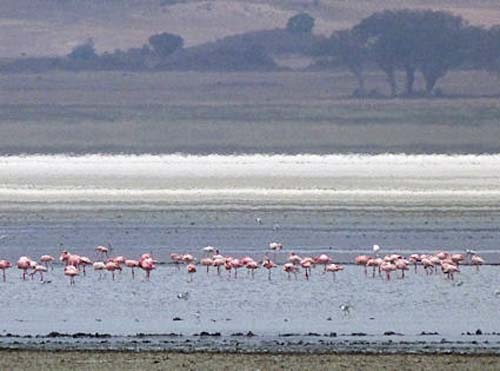
Photo taken from far away on a rainy day—flamingos and the shimmering salt strip left over from what was once a much bigger lake.
We also saw the funniest ostriches in the Ngorongoro crater. The male, black and white, was clearly in mating mood and started running towards the female, grey, who was first running desperately away from him. A trick? The male did a spectacular mating dance, fluffing up all his feathers and flopping his head and neck from one side to the other to show them off. Then after she too had had her mating dance, he walked up to her and then passed by without even paying any attention to her. These mating games are not for us humans to understand.[9]
Just a farewell picture of the magic crater as we are on our way down for the second time, on the day we are going back to Arusha.
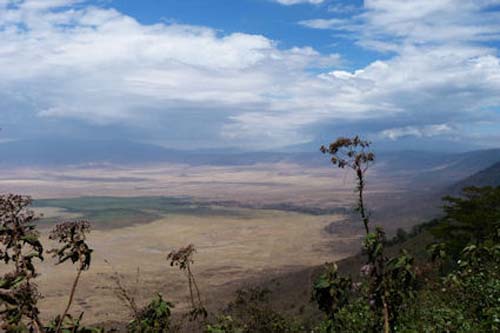
The wonderful magic crater as we are leaving for Arusha on our last day in Ngorongoro Conservation Area.
Another world, another planet. The law of the jungle in the wilderness seems so much more peaceful and friendly than the law of the jungle that is prevailing in the world that we so self-righteously call the ‘civilized’ world.
The most horrible danger today in this part of the world is the projected construction of a highway through the Serengeti national park.[10] This would be a looming disaster to ecosystems and even to the livelihood of Tanzanians themselves.
Quote from ‘Will a Highway Destroy the Serengeti?’
“A commercial highway would be the end of the great migration as we know it. The ecosystem would become fragmented in a critical, narrow path of the migration.
. . .
“We are in a decisive phase of conservation in East Africa. The Serengeti ecosystem is the icon of our world’s great protected areas, and we need to build a strong presence to keep it alive.”
Can we even hope to finally beat the human predators and save the earth from corporate destruction?
Notes:
[1] More about the history of Tanzania at Wikipedia
[2] After independence many African leaders embraced socialism as a political ideology and identity. What has become of this concept in the 21st century?
[3] Beyond Nuclear-Uranium Network: Stop the Mkuju River Uranium Project at Selous Game Reserve, Tanzania
[4] See my amateurish video ‘Africa—Three giraffes having a get-together with a snack’
[5] See my video ‘Africa—huge hoard of zebras and also wildebeest’
[6] See my video ‘Africa—Hopping wildebeest (gnu) in Tanzania’ at
[7] See my video ‘Africa—bathing elephants’
[8] See my video ‘Africa—fabulous meeting with a lioness and her two cubs’
[9] See my video ‘Africa—Ostriches in mating mood’
[10] Will a Highway Destroy the Serengeti? Our Serengeti Watch Interview
Siv O’Neall is an Axis of Logic columnist, where this essay first appeared, and is based in France. Her insightful essays are republished and read worldwide. She can be reached at siv@axisoflogic.com.

